Related Research Articles

HMS Triumph, originally known as Libertad, was the second of the two Swiftsure-class pre-dreadnought battleships of the Royal Navy. The ship was ordered by the Chilean Navy, but she was purchased by the United Kingdom as part of ending the Argentine–Chilean naval arms race. Triumph was initially assigned to the Home Fleet and Channel Fleets before being transferred to the Mediterranean Fleet in 1909. The ship briefly rejoined the Home Fleet in 1912 before she was transferred abroad to the China Station in 1913. Triumph participated in the hunt for the German East Asia Squadron of Maximilian Graf von Spee and in the campaign against the German colony at Qingdao, China early in World War I. The ship was transferred to the Mediterranean in early 1915 to participate in the Dardanelles Campaign against the Ottoman Empire. She was torpedoed and sunk off Gaba Tepe by the German submarine U-21 on 25 May 1915.
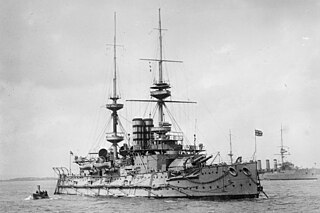
The Majestic class of nine pre-dreadnought battleships were built for the Royal Navy in the mid-1890s under the Spencer Programme, named after the First Lord of the Admiralty, John Poyntz Spencer. With nine units commissioned, they were the most numerous class of battleships. The nine ships, HMS Majestic, Caesar, Hannibal, Illustrious, Jupiter, Magnificent, Mars, Prince George, and Victorious, were built between 1894 and 1898 as part of a programme to strengthen the Royal Navy versus its two traditional rivals, France and Russia. This continued the naval re-armament initiatives begun by the Naval Defence Act 1889.

The Royal Sovereign class was a group of eight pre-dreadnought battleships built for the Royal Navy in the 1890s. The ships spent their careers in the Mediterranean, Home and Channel Fleets, sometimes as flagships, although several were mobilised for service with the Flying Squadron in 1896 when tensions with the German Empire were high following the Jameson Raid in South Africa. Three ships were assigned to the International Squadron formed when Greek Christians rebelled against the Ottoman Empire's rule in Crete in 1897–1898.
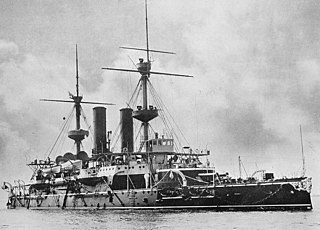
HMS Hood was a modified Royal Sovereign-class pre-dreadnought battleship built for the Royal Navy in the early 1890s. She differed from the other ships of the class in that she had cylindrical gun turrets instead of barbettes and a lower freeboard. She served most of her active career in the Mediterranean Sea, where her low freeboard was less of a disadvantage. The ship was placed in reserve in 1907 and later became the receiving ship at Queenstown, Ireland. Hood was used in the development of anti-torpedo bulges in 1913 and was scuttled in late 1914 to act as a blockship across the southern entrance of Portland Harbour after the start of World War I.

HMS Prince of Wales was a London-class pre-dreadnought battleship built for the Royal Navy in the first decade of the 20th century. She was one of two ships of the London- or Queen sub-class. Shortly after completion the ship was assigned to the Mediterranean Fleet and then to the Atlantic in 1909 and Home Fleets three year later. Prince of Wales often served as a flagship during her career.

Barbettes are several types of gun emplacement in terrestrial fortifications or on naval ships.
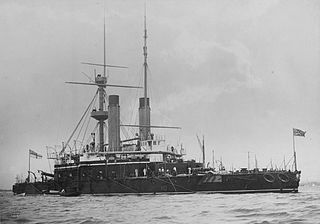
HMS Nile was one of two Trafalgar-class ironclad battleships built for the Royal Navy during the 1880s. Late deliveries of her main guns delayed her commissioning until 1891 and she spent most of the decade with the Mediterranean Fleet. Nile returned home in 1898 and became the coast guard ship at Devonport for five years before she was placed in reserve in 1903. The ship was sold for scrap in 1912 and broken up at Swansea, Wales.

HMS Queen was a member of the London class of pre-dreadnought battleships built for the British Royal Navy. The Londons were near repeats of the preceding Formidable-class battleships, but with modified armour protection. Due to slight differences between Queen and HMS Prince of Wales and the other Londons, they are sometimes referred to as the Queen class. The ship's main battery consisted of four 12-inch (305-mm) guns, and she had top speed of 18 knots. The ship was laid down in March 1901, was launched in March 1902, and was completed in March 1904. After commissioning in April 1904, she served with the Mediterranean Fleet until 1906, when she returned to Britain before embarking on another stint with the Mediterranean Fleet later that year. Queen was transferred back to the United Kingdom in 1908 and thereafter served in the Atlantic Fleet, the Home Fleet, and finally the 5th Battle Squadron of the Second Fleet in 1914.

HMS Revenge was one of seven Royal Sovereign-class pre-dreadnought battleships built for the Royal Navy during the 1890s. She spent much of her early career as a flagship for the Flying Squadron and in the Mediterranean, Home and Channel Fleets. Revenge was assigned to the International Squadron blockading Crete during the 1897–1898 revolt there against the Ottoman Empire. She was placed in reserve upon her return home in 1900, and was then briefly assigned as a coast guard ship before she joined the Home Fleet in 1902. The ship became a gunnery training ship in 1906 until she was paid off in 1913.

HMS Repulse was one of seven Royal Sovereign-class pre-dreadnought battleships built for the Royal Navy in the 1890s. Assigned to the Channel Fleet, where she often served as a flagship, after commissioning in 1894, the ship participated in a series of annual manoeuvres, and the Queen Victoria's Diamond Jubilee Fleet Review during the rest of the decade. Repulse was transferred to the Mediterranean Fleet in 1902 and remained there until December 1903, when she returned home for an extensive refit. After its completion in 1905, Repulse was assigned to the Reserve Fleet until she was sold for scrap in 1911.

The Swiftsure class was a group of two British pre-dreadnought battleships. Originally ordered by Chile as the Constitución class during a period of high tension with Argentina, they were intended to defeat a pair of armoured cruisers ordered by the latter country and were optimized for this role. This meant that they were smaller and more lightly armed than most battleships of the time. They were purchased by the United Kingdom in 1903 prior to their completion to prevent their purchase by the Russian Empire as tensions were rising between them and the Japanese Empire, a British ally. Completed the following year, Swiftsure and Triumph had roughly similar careers for the first decade of their service careers. They were initially assigned to the Home Fleet and Channel Fleets before being transferred to the Mediterranean Fleet in 1909. Both ships rejoined the Home Fleet in 1912 and were transferred abroad in 1913, Swiftsure to the East Indies Station as its flagship, and Triumph to the China Station.

HMS Russell was a Duncan-class pre-dreadnought battleship of the Royal Navy commissioned in 1903. Built to counter a group of fast Russian battleships, Russell and her sister ships were capable of steaming at 19 knots, making them the fastest battleships in the world. The Duncan-class battleships were armed with a main battery of four 12-inch (305 mm) guns and they were broadly similar to the London-class battleships, though of a slightly reduced displacement and thinner armour layout. As such, they reflected a development of the lighter second-class ships of the Canopus-class battleship. Russell was built between her keel laying in March 1899 and her completion in February 1903.

HMS Royal Sovereign was the lead ship of the seven ships in her class of pre-dreadnought battleships built for the Royal Navy in the 1890s. The ship was commissioned in 1892 and served as the flagship of the Channel Fleet for the next five years. She was transferred to the Mediterranean Fleet in 1897 and returned home in 1902, and was briefly assigned as a coast guard ship before she began a lengthy refit in 1903–1904. Royal Sovereign was reduced to reserve in 1905 and was taken out of service in 1909. The ship was sold for scrap four years later and subsequently broken up in Italy.
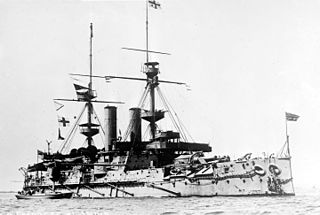
HMS Empress of India was one of seven Royal Sovereign-class pre-dreadnought battleships built for the Royal Navy during the 1890s. The ship was commissioned in 1893 and served as the flagship of the second-in-command of the Channel Fleet for two years. She was transferred to the Mediterranean Fleet in 1897, during which time Empress of India was assigned to the International Squadron blockading Crete during the uprising there. She returned home in 1901 and was briefly assigned as a coast guard ship in Ireland before she became the second flagship of the Home Fleet. The ship was reduced to reserve in 1905 and accidentally collided with the submarine HMS A10 the following year. Empress of India was taken out of service in early 1912 and accidentally struck a German sailing ship while under tow. She was sunk as a target ship in 1913.

HMS Royal Oak was one of seven Royal Sovereign-class pre-dreadnought battleships built for the Royal Navy during the 1890s. Upon her completion in 1894, she was initially placed in reserve until mobilised in 1896 for service with the Flying Squadron. After returning briefly to reserve, the ship was assigned the following year to the Mediterranean Fleet. Royal Oak remained there until 1902 when she returned home; after a refit, the ship was assigned to the Home Fleet, where she served as the flagship of the fleet's second-in-command in 1904–05. Royal Oak was then reduced to reserve until she was taken out of service in 1911. The ship was sold for scrap in early 1914.

HMS Barfleur was the second and last of the Centurion-class pre-dreadnought battleships built for the Royal Navy in the 1890s. Intended for service abroad, they exchanged heavy armour and a powerful armament for high speed and long range to counter the foreign armoured cruisers then being built as commerce raiders and were rated as second-class battleships.

HMS Renown was a second-class predreadnought battleship built for the Royal Navy in the early 1890s. Intended to command cruiser squadrons operating on foreign stations, the ship served as the flagship of the North America and West Indies Station and the Mediterranean Fleet early in her career. Becoming obsolete as cruiser speeds increased, Renown became a royal yacht and had all of her secondary armament removed to make her more suitable for such duties. She became a stoker's training ship in 1909 and was listed for disposal in 1913. The ship was sold for scrap in early 1914.
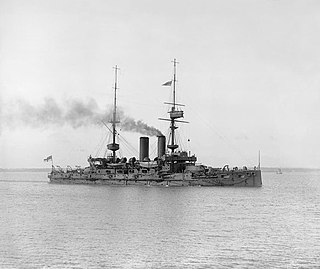
The London class was a group of five predreadnought battleships built for the British Royal Navy in the late 1890s and early 1900s. The class comprised London, Bulwark, Venerable, Queen, and Prince of Wales. The ships of the London class were very similar to the preceding Formidable class, with the main differences being their armour layout. They were armed with a battery of four 12-inch (305 mm) guns and they had top speed of 18 knots. They are sometimes referred to as being part of the Formidable class due to their similarity, or as being a class of three ships, with the last two forming their own Queen class. The five ships were built between 1898 and 1904 at the Portsmouth, Devonport, and Chatham Dockyards.
References
- Burt, R. A. (1988). British Battleships 1889–1904. Annapolis, Maryland: Naval Institute Press. ISBN 0-87021-061-0.